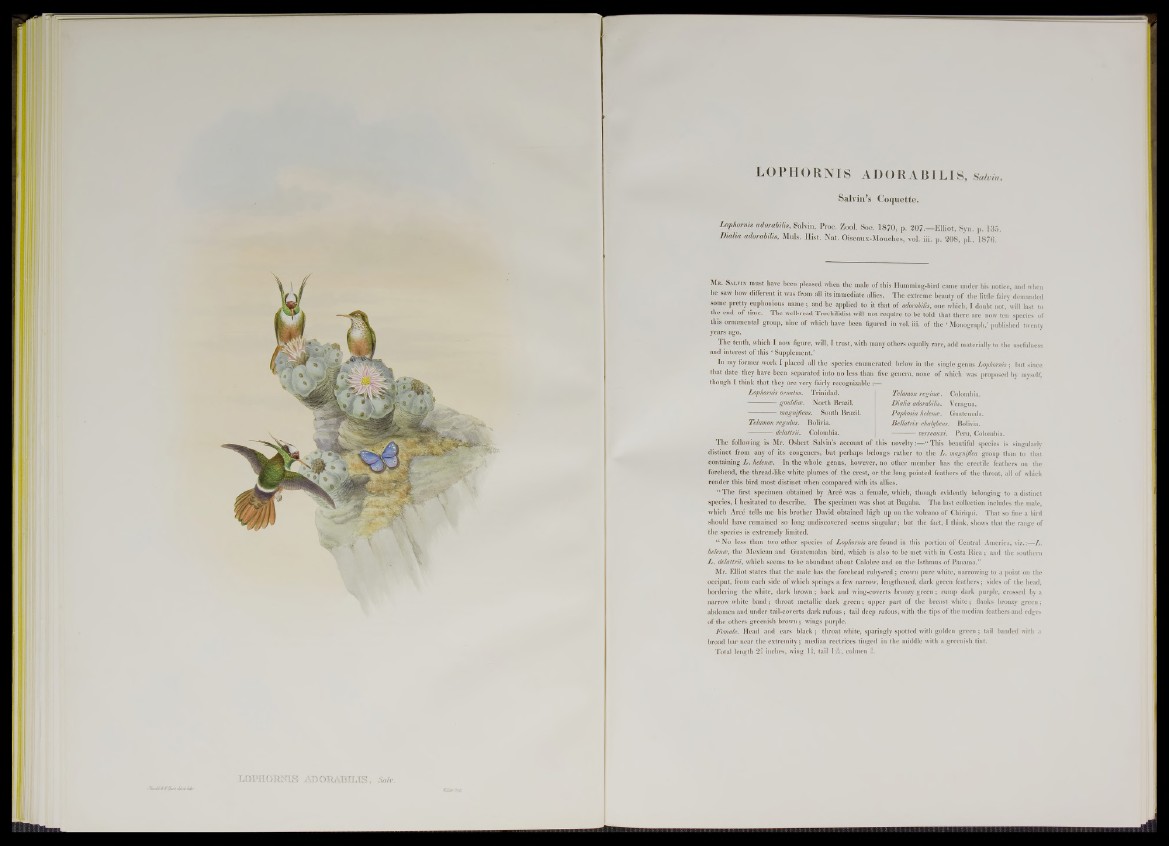
JGouMrfritfffarù,t/rlr(ùiztfi/
XOPHOHNIS .ABQBABILIS, Sala
LOPHORNIS ADORABILIS, Saivin.
Sal vid’s Coquette.
Lophomis adorabilis, Saivin, Proc. Zool. Soc. 1 8 7 0 , p. 2 0 7 .— Elliot, Syn. p. 135.
D ia lia adorabilis, Mula. I lis t. Nat. Oiseaux-Mouches, vol. iii. p. 2 0 8 , pl., 1876.
M b. Salvin must have been pleased when the male of this Humming-bird came under his notice, and when
he saw how different it was from all its immediate allies, The extreme beauty of the little fairy demanded
some pretty euphonious name; and he applied to it that of adorabilis, one which, I doubt not, will last to
the end o f time. The well-read Trochilidist will not require to be told that there are now ten species of
this ornamental group, nine o f which have been figured in vol. iii. of the • Monograph,' published twenty
years ago.
The tenth, which I now figure, will, I trust, with many others equally rare, add materially to the usefulness
and interest o f this ‘ Supplement.’
In my former work I placed all the species enumerated below in the single genus Lophornis ; but since
that date they have been separated into no less than five genera, none of which was proposed by myself,
though I think that they are very fairly recognizable :—
Lophornis ornatus. Trinidad. I Telamon regince. Colombia.
-------------gouldice. North Brazil. Dialia adorabilis. Veragua.
- magnificus. South Brazil. Paphosia helence. Guatemala.
Telamon regains. Bolivia. Bellatrix chalybeus. Bolivia.
------------ delattrii. Colombia. | verreauxi. Peru, Colombia.
The following is Mr. Osbert Salvin’s account o f this novelty:—“ This beautiful species is singularly
distinct from any of its congeners, but perhaps belongs rather to the L . magnifica group than to that
containing L . helence. In the whole genus, however, no other member has the erectile feathers on the
forehead, the thread-like white plumes of the crest, or the long pointed feathers of the throat, all of which
render this bird most distinct when compared with its allies.
“ The first specimen obtained by Arce was a female, which, though evidently belonging to a distinct
species, I hesitated to describe. The specimen was shot at Bugaba. The last collection includes the male,
which Arce tells me his brother David obtained high up on the volcano o f Chiriqui. That so fine a bird
should have remained so long undiscovered seems singular; but the fact, I think, shows that the range of
the species is extremely limited.
“ No less than two other species o f Lophornis are found in this portion of Central America, viz.:—L.
helence, the Mexican and Guatemalan bird, which is also to be met with in Costa Rica; and the southern
L . delattrii, which seems to be abundant about Calobre and on the Isthmus o f Panama.”
Mr. Elliot states that the male has the forehead ruby-red; crown pure white, narrowing to a point on the
occiput, from each side o f which springs a few narrow, lengthened, dark green feathers; sides of the head,
bordering the white, dark brown; back and wing-coverts bronzy green; rump dark purple, crossed by a
narrow white band; throat metallic dark green; upper part of the breast white; flanks bronzy green;
abdomen and under tail-coverts dark rufous; tail deep rufous, with the tips of the median feathers and edges
of the others greenish brown ; wings purple.
Female. Head and ears black ; throat white, sparingly spotted with golden green; tail banded with a
broad bar near the extremity; median rectrices tinged in the middle with a greenish tint.
Total length 2 f inches, wing If, tail 1 he, culmen I.